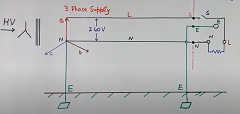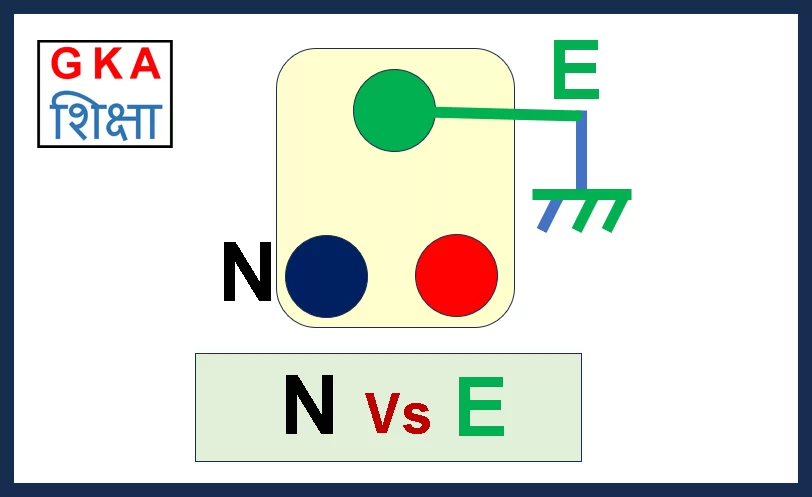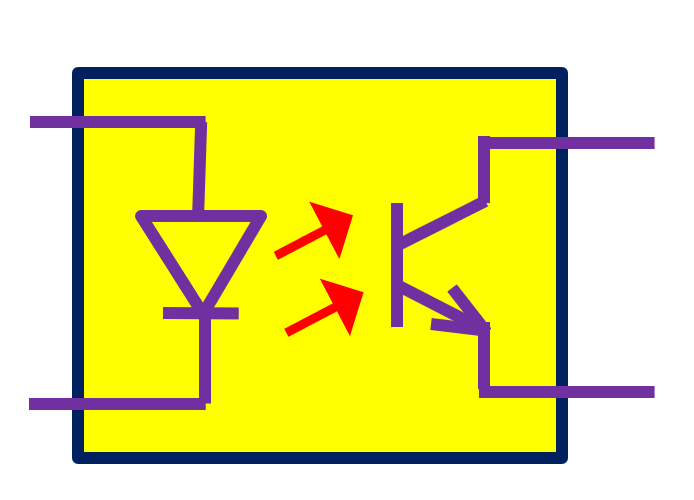I will explain the difference between the neutral wire and earth in the AC supply in this technical article. We will discuss a total of 17 differences between neutral and earth in this article.
The three-phase AC supply consists of 4 wires. R phase, Y phase, B phase wires, and a neutral wire. In addition to that, we have earth wire also. If the load is single phase then the neutral wire and one of the three-phase wires supply the power to the load.
The neutral wire and earth wire of the AC supply has totally different purpose.
The difference between the neutral wire and earth wire
The main difference between neutral and earth is that neutral wire is for the current flow of the load, but earth wire is for safety and protection.
There are many other differences also between neutral and earth wire.
1 – Neutral wire comes from the neutral of the electrical transformer from the substation. But earth wire does not come from the substation AC supply. We connect the earth wire to the earth locally. Refer to figure 1.

In the above circuit, there is a separate wire for the neutral coming from the transformer. But there is no earth wire coming from the transformer. Instead, we connect the earth wire to the earth.
Further, only one method of neutral earth arrangement is shown above. There are a few other methods of neutral earth arrangements depending on applications.
2 – At the substation, the neutral of the transformer is connected to the earth. But at home, the neutral and earth wires are not connected with each other. refer to figure 1 above.
So, the voltage of neutral at the transformer side is zero. But the voltage of neutral at the load side is not zero. But the voltage of the earth at both ends is zero volts as a reference.
3 – We always connect the load between the line and the neutral wire. We do not connect the load between the line and the earth wire.
4 – The body of the electrical equipment like the heater, refrigerator, etc is connected to the earth wire. We do not connect the body with a neutral wire.
5 – As said above, the neutral wire is for the load current. But the earth wire is for safety and protection.
6 – The earth pin of three pin plug and socket is thicker and longer than a neutral pin. This is to make sure that the first earth connection takes place for safety reasons.
7 – The neutral wire in the three-phase supply is for the unbalance current flow in three phase supply. And there will be a voltage drop in the neutral due to this unbalance current. The earth wire has no voltage drop concept.
8 – Earth wire is also useful for noise suppression. We connect the metal body or case of the control panels to the earth with earth wire to suppress the external electrical noise.
9 – We use earth wire to discharge the capacitor banks for safety reasons. As any leftover DC voltage across the capacitor is very unsafe for humans. And the capacitor may take a very long time to discharge itself.
10 – During maintenance or repair of high-voltage equipment, all the line, and neutral parts are connected to the earth for safety. We do not use neutral wire for this purpose.
11 – One more difference between the neutral wire and earth is that the neutral wire always has insulation over copper wire. But in the case of earth wire, it may be without insulation in many cases. Sometimes copper bus bars are used as earth wire.
12 – Further another difference between the neutral wire and earth wire is that all the houses in the locality share the common neutral wire. But all the houses have their own separate earth wire and earthing system.
13 – The equipment with plastic casing nowadays has a neutral wire always. But they do not have the earth wire always. This is because it is safe to touch the plastic body of the equipment.
14 – The current flowing in the neutral wire is the zero sequence current of the unbalanced load. But the current flowing in the earth wire is the leakage current.
15 – It is not safe to touch the conductor of the neutral wire. But it is safe to touch earth wire.
16 – Further difference between neutral and earth wire is that the line and neutral wire are interchangeable in many electrical appliances, for example, electric fans nowadays. But earth wire can not be used this way.
17 – In industrial equipment, we test the neutral point for high voltage surge also. But no such test for earth connection except for the proper continuity test.
Conclusion
There are many differences between neutral and earth wire. The neutral wire is useful for the main current flow. But earth wire is basically for safety and protection purposes for humans and equipment.
Extra knowledge as per experience and exceptions
There are a few exceptions in using the earth wire as follows
1 – In the electric train, there is no separate neutral wire. The earth wire (both rails) itself acts as a return path. But this is on an exclusive right-of-way basis. This is due to the reason that the train gets the AC supply from only one wire through the catenary from a high voltage supply.
2 – In the high voltage testing lab also, the earth wire itself acts as the return path. But again, this is a well-protected area, and the current flow in the earth is only within the lab electrical circuit.
3 – In the case of HVDC transmission, the earth itself acts as a return path during single pole operation or during faults. A current of a few thousand amperes can flow in the earth for a very long distance and for a very long time.
For detail watch the video on neutral VS earth
Further also read, what is the wind power supply
Related article – Substation transformer neutral earthing.
Also read, what is SMPS transformer.
Further, read applications of the Zener diode
Keep learning by reading Why neutral wire in a 3-phase induction motor?
I hope that you enjoyed the article on the difference between neutral wire and earth.
If so, then subscribe to my YouTube channel.
About the author – G K Agrawal B.Sc and B.Tech (from HBTU Kanpur), Retd. Sr DGM Design (BHEL), the inventor of patents, has lifelong industry experience in the electrical and electronics design field of R&D. He worked for BHEL. He shares his experience and knowledge on blogs and YouTube. Read the profile here.




Very detailed information.